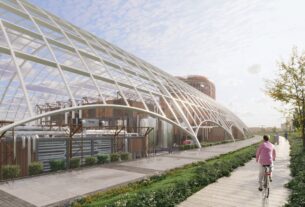Throughout April, we are featuring the articles shortlisted for the 2022 Harper Prize. The Harper Prize is an annual award for the best early career research paper published in Journal of Ecology. Miriam Gerhard’s article ‘Environmental stoichiometry mediates phytoplankton diversity effects on communities’ resource use efficiency and biomass’ is one of those shortlisted for the award.
⭐️About me: between South and North
I was born in Uruguay and since I was a child I have felt an immense curiosity and fascination for nature, but also concern for how we humans relate to it, especially with water. This prompted me to study biology and obtain my master degree in ecology and evolution (at the Universidad de la República, Uruguay). I choose limnology as my field study and during my professional working experience, I participated in freshwater monitoring programs and worked as environmental consultant. After that, I felt the necessity to strengthen my theoretical ecological background so I left to do a PhD in Germany at the Institute for Chemistry and Biology of the Marine Environment (University of Oldenburg) co-funded by the Uruguayan Agency of Investigation and Innovation (ANII) and the German Academic Exchange Service (DAAD). During that time, I worked in experimental ecology from laboratory to mesocosms scale analyzing phytoplankton community responses to environmental change, providing empirical evidence for ecological theories (e.g. ecological stoichiometry, metabolic scaling theory, Jensen’s inequality rule, growth rate hypothesis, and biodiversity ecosystem-functioning relationship). Currently, I am back in Uruguay and have a postdoc position at the Department of Ecology and Environmental Management (Universidad de la República, Centro Universitario Regional Este) since I got a proposal funded by the DFG to develop and lead my own project, in a cooperation among Uruguay, Germany and Brazil.
🔎About the shortlisted paper: Environmental stoichiometry, diversity and ecosystem functioning
The shortlisted paper is part of my PhD work and involved a great time in the mesocosm facility at the ICBM in Wilhelmshaven, where I worked with a fantastic team conducting micro and mesocosm experiments (as well as the best mix of latin and german music🙂).

We experimentally tested the effect of nutrient balance (i.e. nutrient ratios) on phytoplankton resource use efficiency (RUE) and biomass, and how the nutrient context mediates biodiversity-ecosystem functioning (BEF) relationships. Although these aspects have been theoretically analyzed and investigated through modelling, they lacked experimental evidence. A phytoplankton diversity gradient was generated by dilution of a natural community obtaining a rare species gradient. These communities were exposed to different nitrogen (N) and phosphorus (P) concentrations with uniform (i.e. same) N:P ratios, and to a N:P ratio gradient. Therewith, conditions with different variability in resource supply were generated. Our results showed that imbalanced N:P ratios did not result in a phytoplankton biomass decline as suggested by theory. However, a wide range of nutrient conditions was fundamental to mediate phytoplankton diversity effects on RUE and standing biomass supporting the idea that positive BEF relationships are detected when combining variable environmental conditions and high diversity as proposed in conceptual and modelling studies. These results suggest that rare species might have an important role in maintaining ecosystem processes under environmental changing conditions.
Overall, the manuscript provides experimental evidence on theoretical predictions (some accepted and some rejected) regarding the relationship among diversity, resource availability, and community biomass: a subject widely covered from a conceptual point of view (but neglected experimentally) and with great relevance in a context of biodiversity crisis and its consequences on ecosystem functioning. At the same time, the experimental design aimed to approach conditions closer to nature by: simulating non-random species losses (generating a gradient of rare species), manipulating a species diversity as high as in natural lakes, using species that co-occur in nature and have the same environmental history.

🌿Current research: Variability and collaboration
One of my general career objectives is to find ways of linking different disciplines within ecology, combining theory, experimental approaches and field observations, and make the resulting knowledge accessible to managers and policy makers. I truly believe that cooperation is the way to approach fundamental anthropic impacts on our ecosystems, and is even more important considering the global changes we are facing. However, international collaborations might be challenging since different cultures and socio-economic context are involved. In order to contribute to this aspect, my project involves a collaboration among Uruguay, Brazil and Germany, in an attempt to enhance the network between South America and Europe.
Specifically, I investigate plankton communities’ responses to environmental change, using experimental approaches at different scales to develop a mechanistic understanding of the involved processes. My aim is to fill relevant gaps of knowledge in the exciting field of environmental variability under multiple stressor context and contribute to aquatic ecology by experimentally testing theoretical predictions about changes in mean and fluctuating temperature at the community level in closer to nature scenarios.
Find Miriam on Twitter and GoogleScholar.
Read the full list of articles shortlisted for the 2022 Harper Prize here.

